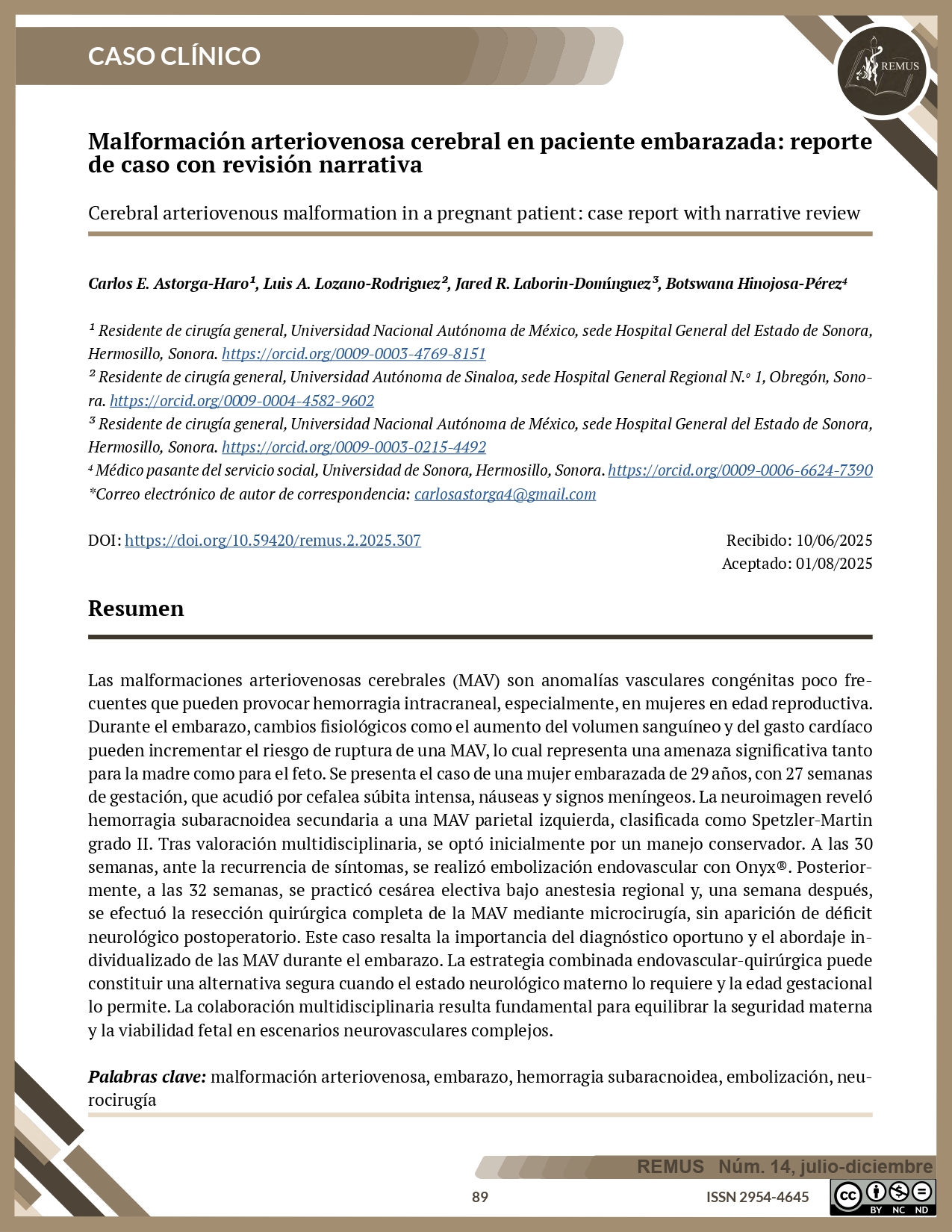Malformación arteriovenosa cerebral en paciente embarazada: reporte de caso con revisión narrativa
Cerebral arteriovenous malformation in a pregnant patient: case report with narrative review
DOI:
https://doi.org/10.59420/remus.2.2025.307Palabras clave:
Malformación arteriovenosa, embarazo, hemorragia subaracnoidea, embolización, neurocirugíaResumen
Las malformaciones arteriovenosas cerebrales (MAV) son anomalías vasculares congénitas poco frecuentes que pueden provocar hemorragia intracraneal, especialmente, en mujeres en edad reproductiva. Durante el embarazo, cambios fisiológicos como el aumento del volumen sanguíneo y del gasto cardíaco pueden incrementar el riesgo de ruptura de una MAV, lo cual representa una amenaza significativa tanto para la madre como para el feto. Se presenta el caso de una mujer embarazada de 29 años, con 27 semanas de gestación, que acudió por cefalea súbita intensa, náuseas y signos meníngeos. La neuroimagen reveló hemorragia subaracnoidea secundaria a una MAV parietal izquierda, clasificada como Spetzler-Martin grado II. Tras valoración multidisciplinaria, se optó inicialmente por un manejo conservador. A las 30 semanas, ante la recurrencia de síntomas, se realizó embolización endovascular con Onyx®. Posteriormente, a las 32 semanas, se practicó cesárea electiva bajo anestesia regional y, una semana después, se efectuó la resección quirúrgica completa de la MAV mediante microcirugía, sin aparición de déficit neurológico postoperatorio. Este caso resalta la importancia del diagnóstico oportuno y el abordaje in
dividualizado de las MAV durante el embarazo. La estrategia combinada endovascular-quirúrgica puede constituir una alternativa segura cuando el estado neurológico materno lo requiere y la edad gestacional lo permite. La colaboración multidisciplinaria resulta fundamental para equilibrar la seguridad materna y la viabilidad fetal en escenarios neurovasculares complejos.
Descargas
Citas
Sugiyama T, Grasso G, Torregrossa F, Fujimura M. Current concepts and perspectives on brain arteriovenous malformations: A review of pathogenesis and multidisciplinary treatment. World Neurosurg [Internet]. 2022;159:314–26. Disponible en: http://dx.doi.org/10.1016/j.wneu.2021.07.106
De Maria L, Serioli S, Fontanella MM. Brain arteriovenous malformations and pregnancy: A systematic review of the literature. World Neurosurg [Internet]. 2023;177:100–8. Disponible en: http://dx.doi.org/10.1016/j.wneu.2023.06.065
Pohjola A, Vest T, Verho L, Aarnio K, Rantanen K, Laivuori H, et al. Intracranial arteriovenous malformations during pregnancy and puerperium-A retrospective nationwide population-based cohort study. Neurosurgery [Internet]. 2025;96(2):346–55. Disponible en: http://dx.doi.org/10.1227/neu.0000000000003067
Izumo T, Okamura K, Takahira R, Matsunaga Y, Sadakata E, Maeda H, et al. Impact of pre-operative embolization with Onyx for brain arteriovenous malformation surgery. Front Neurol [Internet]. 2022;13:875260. Disponible en: http://dx.doi.org/10.3389/fneur.2022.875260
Korhonen A, Verho L, Aarnio K, Rantanen K, Saaros A, Laivuori H, et al. Subarachnoid hemorrhage during pregnancy and puerperium: A population-based study. Stroke [Internet]. 2023;54(1):198–207. Disponible en: http://dx.doi.org/10.1161/STROKEAHA.122.039235
Che Yusof R, Norhayati MN, Mohd Azman Y. Arteriovenous malformation hemorrhage in pregnancy: A systematic review and meta-analysis. Int J Environ Res Public Health [Internet]. 2022;19(20):13183. Disponible en: http://dx.doi.org/10.3390/ijerph192013183
Fang W, Yang Z, Liu Y, Yu J, Sun P, Zhao Z, et al. Peri-procedure efficacy and safety of one-stop hybrid surgery for the treatment of brain arteriovenous malformations: A single-center preliminary experience. Front Neurol [Internet]. 2022;13:1052882. Disponible en: http://dx.doi.org/10.3389/fneur.2022.1052882
Derdeyn CP, Zipfel GJ, Albuquerque FC, Cooke DL, Feldmann E, Sheehan JP, et al. Management of brain arteriovenous malformations: A scientific statement for healthcare professionals from the American heart association/American stroke association. Stroke [Internet]. 2017;48(8):e200–24. Disponible en: http://dx.doi.org/10.1161/STR.0000000000000134
Etter MM, Nguyen A, Brehm A, Aberle C, Tsogkas I, Guzman R, et al. Endovascular treatment and Peri-interventional management of ruptured cerebrovascular lesions during pregnancy : Case series and case-based systematic review: Case series and case-based systematic review. Clin Neuroradiol [Internet]. 2023;33(3):833–42. Disponible en: http://dx.doi.org/10.1007/s00062-023-01287-x
Dauer LT, Thornton RH, Miller DL, Damilakis J, Dixon RG, Marx MV, et al. Radiation management for interventions using fluoroscopic or computed tomographic guidance during pregnancy: a joint guideline of the Society of Interventional Radiology and the Cardiovascular and Interventional Radiological Society of Europe with Endorsement by the Canadian Interventional Radiology Association. J Vasc Interv Radiol [Internet]. 2012;23(1):19–32. Disponible en: http://dx.doi.org/10.1016/j.jvir.2011.09.007
Takeuchi Y, Sakata H, Ishida T, Ezura M, Endo H. Optimal intervention for ruptured cerebral arteriovenous malformation during pregnancy. Surg Neurol Int [Internet]. 2025;16:238. Disponible en: http://dx.doi.org/10.25259/SNI_320_2025
Zeleňák K, Šalát D, Kolarovszki B, Kurča E, Zeleňáková J, Koçer N. Embolization of ruptured infratentorial pial AVM in pregnancy. Life (Basel) [Internet]. 2023;13(4). Disponible en: http://dx.doi.org/10.3390/life13040896

Descargas
Publicado
Cómo citar
Número
Sección
Licencia
Derechos de autor 2025 REMUS - Revista Estudiantil de Medicina de la Universidad de Sonora

Esta obra está bajo una licencia internacional Creative Commons Atribución-NoComercial-SinDerivadas 4.0.

